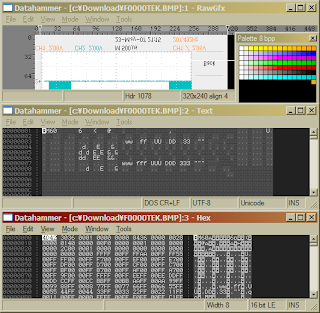This place is to dump thoughts around the ongoing development of the Datahammer Editor.
So, why making another editor?
Computing has become high-level in recent years. Over are the days where you had to have assembly or BASIC programming skills to be able to use a computer. Fortunately, this has enabled many to get access to information technology, but on the downside people forget how things work.
People use photo managers, web browsers, word processing. But if you ask the average computer user about file formats, memory layout, or his file system, he will give you a strange look at best.
Now the thing is, software has become high-level, too. After years of user-suffering everything just works! You can open large files, drag and drop pictures between applications, print out what you see on the screen, connect computers over a network! Gone is the need for low-level utilities such as disk editors, memory monitors to tweak stuff.
This is a problem.
Knowledge about how computers work is getting lost. I am not saying people should learn to code, but a minimum level of technical education gained through playing around with software would help to slow down this knowledge drain.
Especially kids, who use to explore things, don't have the software tools anymore that teach them things. As a result fewer and fewer young people get into an IT career, and those who go that way, aren't educated as profound as the 80's 8-bit computer kid.
Sure, there are still low-level tools, most Win32 or Unix command line tools are low-level, but the good old feel of software from the 8 bit days of being 'close to the silicon' and its educative value is gone.
That is one of the reasons for developing Datahammer.
While any text or hex editor can be used to look at data, with Datahammer we are trying to be smart about it. You can look at a file in text mode, hex dump, disassembly, graphics dump, audio dump, and thanks to mode-plugins many more. It has no filesize restrictions, is fast, it does no hidden changes to an opened file, and it tries to make sense and be complete. It is meant to juggle data around, easily look at it from many different angles, ultimately leading to a better understanding for both, beginners and professionals.
2008-03-23
Welcome
Labels:
Datahammer
